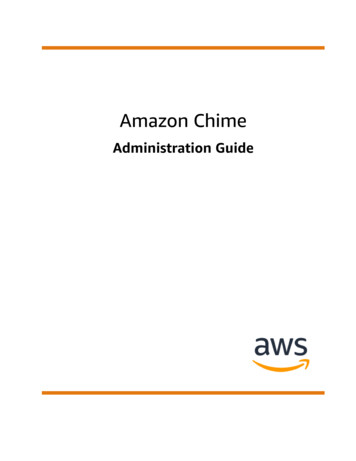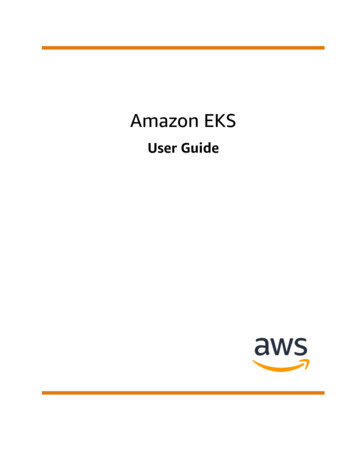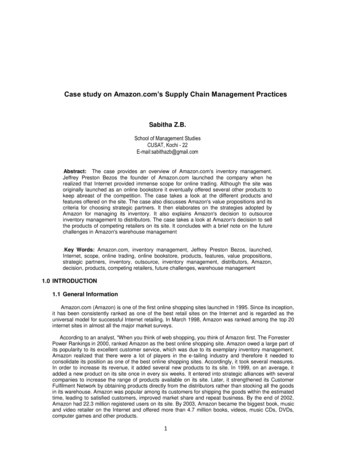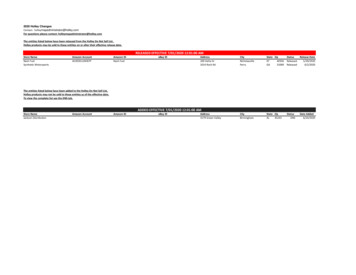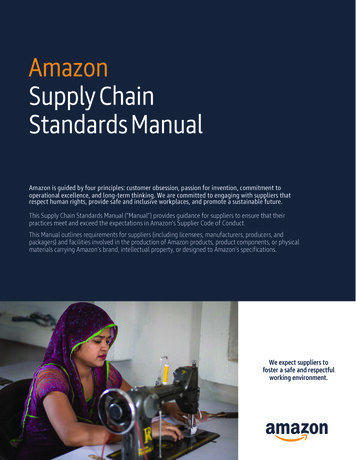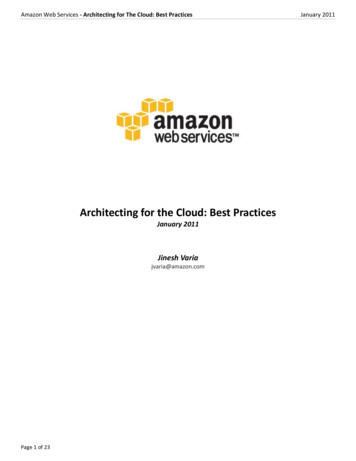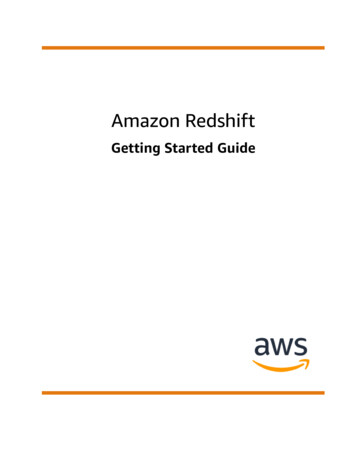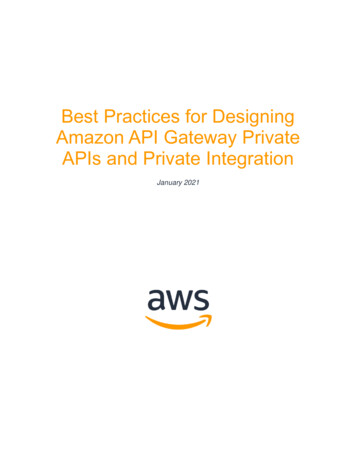
Transcription
Best Practices for DesigningAmazon API Gateway PrivateAPIs and Private IntegrationJanuary 2021
NoticesCustomers are responsible for making their own independent assessment of theinformation in this document. This document: (a) is for informational purposes only, (b)represents current AWS product offerings and practices, which are subject to changewithout notice, and (c) does not create any commitments or assurances from AWS andits affiliates, suppliers or licensors. AWS products or services are provided “as is”without warranties, representations, or conditions of any kind, whether express orimplied. The responsibilities and liabilities of AWS to its customers are controlled byAWS agreements, and this document is not part of, nor does it modify, any agreementbetween AWS and its customers. 2021 Amazon Web Services, Inc. or its affiliates. All rights reserved.
ContentsIntroduction .1Overview of Amazon API Gateway .1Rest API .2Private Endpoint Type .2Private Integration .5Sample Architecture Patterns .5WebSocket API.9Private Integration .9Sample Architecture Pattern .9HTTP API .10Private Integration .11Sample Architecture Patterns .11Security .13Cost Optimization .14Conclusion .16Contributors .16Further Reading .17Document Revisions.17
AbstractFor many enterprise customers, AWS Direct Connect or a virtual private network (VPN)is often used to build a network connection between an on-premises network and anAmazon Web Services (AWS) virtual private cloud (VPC). This adds additionalcomplexity to a network design, and introduces challenges to Amazon API Gatewayprivate API and private integration setup. This whitepaper introduces best practices fordeploying private APIs and private integrations in API Gateway, and discusses security,usability, and architecture.This whitepaper is aimed at developers who use API Gateway, or are considering usingit in the future.
Amazon Web ServicesBest Practices for Designing Amazon API Gateway Private APIs and PrivateIntegrationIntroductionMany customers use Amazon API Gateway to build RESTful and HTTP APIs. If the useof those APIs is limited to internal clients, customers prefer to use private APIs, becauseprivate APIs provide a secure means to invoke APIs via an interface VPC endpoint. APIGateway private integration makes it simple to expose your HTTP/HTTPS resourcesbehind an Amazon VPC, for access by clients outside of the VPC. Additionally, privateintegration can integrate with private APIs, so the APIs can send requests to a NetworkLoad Balancer (NLB) through a private link. For HTTP APIs, Application Load Balancer(ALB) and AWS Cloud Map are also supported. Private integration forwards externaltraffic sent to APIs to private resources, without exposing the APIs to the internet.Based on security requirements, different security measures can be placed at differentsecurity layers. To secure VPC resources such as Elastic Network Interface (ENI),associate resources are associated with a security group. VPC endpoints areassociated with both the security group and the resource policy. For NLB, TransportSecure Layer (TLS) listeners are used to secure a listener. For ALB, security groupsand HTTPS listeners are used.Compared to regional and edge-optimized API implementation, private APIimplementation and private integrations add additional components, such as interfaceVPC endpoints and load balancers. This can lead to additional complexity in applicationarchitectures.This whitepaper includes sample architectures to help understand private APIs, alongwith private integration implementation and best practices. It also covers security andcost optimizations.Overview of Amazon API GatewayAmazon API Gateway is a fully managed service that helps you easily create, publish,maintain, monitor, and secure APIs at any scale. It provides three different types ofAPIs: REST, WebSocket, and HTTP. Depending on your business needs andarchitectural patterns, you can use one or more of the API types:1
Amazon Web ServicesBest Practices for Designing Amazon API Gateway Private APIs and PrivateIntegration The REST API type has three endpoint types: edge-optimized, regional, andprivate. Edge-optimized and regional REST APIs are publicly accessible andserve requests over the internet. For customers who need to access an API in aprivate network, a private REST API is the preferred choice. REST APIs providean easy means to secure APIs such as resource policies, IAM authentication,and custom authorizers. WebSocket APIs enable you to build real-time, two-way communicationapplications such as chat apps and streaming dashboards. Although there is noprivate endpoint type available, WebSocket APIs provide an option to create aroute with a VPC link for private integration. HTTP APIs are the newest type of APIs in API Gateway. They include enhancedfeatures such as auto deployment and cross-origin resource sharing (CORS)support, improved performance, and low costs. HTTP API private integrationswork with Application Load Balancer and AWS Cloud Map, in addition to NetworkLoad Balancer.Rest APIREST APIs help create APIs that follow the REST architectural style. Developers canuse their existing knowledge and apply best practices while building REST APIs in APIGateway.While designing a REST API, a key consideration is security. Use least privilege accesswhen giving access to APIs. The private endpoint type restricts API access throughinterface VPC endpoints only. If REST APIs are publicly exposed but integrationendpoints exist in a private subnet, private integration offers a way to access theendpoints via a VPC link. You can create a VPC link with a Network Load Balancer. APIGateway creates a VPC endpoint service for API Gateway to access Network LoadBalancer.Private Endpoint TypeTo make APIs accessible only from Amazon VPCs, you can use REST APIs with theprivate endpoint type. The traffic to the APIs will not leave the AWS network. There arethree options to invoke a private API through different domain name system (DNS)names: Private DNS names2
Amazon Web ServicesBest Practices for Designing Amazon API Gateway Private APIs and PrivateIntegration Interface VPC endpoint public DNS hostnames Amazon Route53 aliasWhile configuring private APIs, there are several key points to consider. The “DNSNames for Private APIs” section provides use cases, pros, and cons about each option.DNS Names for Private APIsTable 1 – Private API DNS namesPrivate DNSoption on VPCeProsConsPrivate DNSnamesEnabledEasy to set upDNS issue withregional and edgeoptimized APIs.Interface VPCendpoint publicDNS hostnamesDisabledThe domain name ispublicly resolvable.Requires a Host or xapigw-api-id header inrequests.Route53 aliasDisabledThe domain name ispublicly resolvable.The host or x-Requires an interfaceVPC endpointassociation with eachprivate API.DNS namesapigw-api-idheader is notrequired.Private DNS NamesThis option works when the private DNS option on an interface VPC endpoint isenabled. In addition, to resolve the name, AmazonProvidedDNS should be present inthe DHCP options set for the clients in the VPC. Because those are the onlyrequirements, this option is usually easy to use for a simple use case such as invoking aprivate API within a VPC.However, if you use a custom DNS server, a conditional forwarder must be set on theDNS that points to the AmazonProvidedDNS or Route53 Resolver. Because of theprivate DNS option enabled on the interface VPC endpoint, DNS queries against3
Amazon Web ServicesBest Practices for Designing Amazon API Gateway Private APIs and PrivateIntegration*.execute-api.amazonaws.com will be resolved to private IPs of the endpoint. Thiscauses issues when clients in the VPC try to invoke regional or edge-optimized APIs,because those types of APIs must be accessed over the internet. Traffic throughinterface VPC endpoints is not allowed. The only workaround is to use an edgeoptimized custom domain name. See Why do I get an HTTP 403 Forbidden error whenconnecting to my API Gateway APIs from a VPC? for the troubleshooting steps.VPC Endpoint Public DNS HostnamesIf your use case requires the private DNS option to be disabled, consider using interfaceVPC endpoint public DNS hostnames. When you create an interface VPC endpoint, italso generates the public DNS hostname. When invoking a private API through thehostname, you must pass a Host or x-apigw-api-id header.The header requirement can cause issues when the hostname is used in a webapplication. For cross-origin, non-simple requests, modern browsers send a preflightrequest to an endpoint. This option requires clients to send requests with a customheader. Because browsers will not send the custom header for the preflight request, thiswill cause CORS issues. This option is not a preferred option for customers who needto use a private API from a web application.Route 53 AliasThis Route 53 option resolves the header requirement imposed by the VPC endpointpublic DNS hostnames option. Additionally, the Route 53 alias is publicly resolvable,and does not require private DNS to be enabled. Clients in a VPC can access privateAPIs through the Route 53 alias, as well as other types of APIs such as regional andedge-optimized REST APIs.Each alias is generated after associating a VPC endpoint to a private API. Theassociation is required every time you create new interface VPC endpoints and privateAPIs.Resource-Based PolicyResource-based policies are attached to a resource like a REST API in API Gateway.For resource-based policies, you can specify who has access to the resource and whatactions are permitted.Unlike regional and edge-optimized endpoint types, private APIs require the use of aresource policy. Deployments without a resource policy will fail. For private APIs, thereare additional keys within the condition block you can use in the resource policy, such4
Amazon Web ServicesBest Practices for Designing Amazon API Gateway Private APIs and PrivateIntegrationas aws:sourceVpc and aws:SourceVpce. The aws:sourceVpc policy allows traffic tooriginate from specific VPCs, and aws:SourceVpce allows traffic originating frominterface VPC endpoints.Private IntegrationPrivate integrations allow routing traffic from API Gateway to customers’ VPCs. Theintegrations are based on VPC links, and rely on a VPC endpoint service that is tied tonetwork load balancers (NLBs) for REST and WebSocket APIs. VPC link integrationswork in a similar way as HTTP integrations. A common use case is to invoke AmazonEC2-hosted applications behind NLBs through VPC links. There are several designconsiderations in this case: For existing applications with a Classic Load Balancer (CLB) or Application LoadBalancer (ALB:o Create an NLB in front of a CLB or ALB. This creates an additional network hop and infrastructure cost.o Route traffic through NLB instead of CLB or ALB. This requires migration from CLB or ALB to NLB to shift traffic andredesign the existing architecture. See Migrate your Classic LoadBalancer for the migration process.NLB listener typeo Transmission control protocol (TCP) (Secure Socket Layer (SSL)passthrough or non-SSL traffic)o Transport Layer Security (TLS) (terminating the SSL connection on NLB)Sample Architecture PatternsWhen implementing a private API, using an authorizer such as AWS Identity andAccess Management (IAM) or Amazon Cognito is highly recommended. This ensuresan additional layer of security, and helps verify requests using IAM credentials for IAMauthorization, and access/ID tokens for the Amazon Cogito authorizer.Basic ArchitectureIn the basic architecture, Amazon EC2 instances and VPC-enabled AWS Lambdafunctions access a private API through an interface VPC endpoint. The security group5
Amazon Web ServicesBest Practices for Designing Amazon API Gateway Private APIs and PrivateIntegrationattached to the endpoint must allow the Transmission Control Protocol (TCP) port 443.In the private API resource policy, requests from the VPC and interface VPC endpointshould be allowed.Figure 1 – REST private API basic architectureCross-Account ArchitectureIf you want to allow access to a private API from other accounts, an interface VPCendpoint in a different account can be used to invoke the API. However, they both mustexist in the same Region, such as us-east-1 (N. Virginia). Additionally, the private APIresource policy must allow access from the other account’s VPC or interface VPCendpoint.6
Amazon Web ServicesBest Practices for Designing Amazon API Gateway Private APIs and PrivateIntegrationFigure 2 – REST private API cross-account architectureOn-Premises ArchitectureIf you have users accessing from on-premises locations, you will need a Direct Connector VPN connection between the on-premises networks and your VPC. All requests muststill go through interface VPC endpoints. For the on-premises architecture, VPCendpoint public DNS hostnames or Route 53 alias records are good options wheninvoking private APIs. If on-premises users access the network through a webapplication, Route 53 alias records are a better approach to avoid CORS issues. If theRoute 53 alias record option does not work, one solution is to create a conditionalforwarder on an on-premises DNS pointing to a Route 53 resolver. See Resolving DNSqueries between VPCs and your network.7
Amazon Web ServicesBest Practices for Designing Amazon API Gateway Private APIs and PrivateIntegrationThe following diagram shows a sample architecture where on-premises clients access aweb application hosted in the on-premises network. The web application uses a privateAPI for its API endpoint. For the private API endpoint, a Route 53 alias is used.Because a Route 53 alias record is publicly resolvable, there is no need to set up aconditional forwarder on on-premises DNS servers to resolve the hostname.Figure 3 – REST private API on-premises architecturePrivate Integration Architecture with ECSAmazon Elastic Container Service (Amazon ECS) is a fully managed containerorchestration service. Customers can use ECS to run their most sensitive and missioncritical applications because of its security, reliability, and scalability. For privateintegration in REST APIs, one common design pattern is to use an NLB to route trafficto an Amazon ECS cluster in private subnets. Many customers deploy ECS as theirbackend compute service. The following diagram shows clients in one VPC accessingan ECS cluster in another VPC through a private API and private integration.8
Amazon Web ServicesBest Practices for Designing Amazon API Gateway Private APIs and PrivateIntegrationFigure 4 – Cross-VPC ECS Access via Private Integration with Private APIWebSocket APIWebSocket APIs offer APIs that the client can access through the WebSocket protocol.Unlike REST and HTTP APIs, WebSocket APIs allow bidirectional communications.WebSocket APIs are often used in real-time applications such as chat applications,collaboration platforms, multiplayer games, and financial trading platforms.Private IntegrationPrivate integrations with WebSocket APIs are very similar to those using REST APIs.The difference is how responses are handled, because integration responses areoptional in WebSocket API routes. However, integration requests to the VPC links workthe same way as requests to REST APIs, so the same design considerations apply toWebSocket APIs.Sample Architecture PatternCurrently, WebSocket APIs are offered only with a regional endpoint type. The APIsmust be accessed over the internet. Using a private integration, requests through APIscan be routed to EC2 instances or VPC resources through an NLB privately. You canperform TLS termination on a TLS listener of the NLB, or pass the TLS traffic through to9
Amazon Web ServicesBest Practices for Designing Amazon API Gateway Private APIs and PrivateIntegrationthe target group instances. If the TLS termination happens on the target groupinstances, you can implement client certificates generated by API Gateway to enhancesecurity. See Generate and configure an SSL certificate for backend authentication.Sample ArchitectureFigure 5 shows a sample architecture where WebSocket API users access a route keymapped to a VPC link integration method. The NLB has a TLS listener for the domain“example.com”, and listens on TCP port 443. The target group for the listener points toECS services.Figure 5 – WebSocket API private integration with ECSHTTP APIHTTP API is a new flavor of API Gateway. Benefits of using the API include deliveringenhanced features, improved performance, and an easier developer experience. Inaddition, HTTP APIs come with reduced request pricing.10
Amazon Web ServicesBest Practices for Designing Amazon API Gateway Private APIs and PrivateIntegrationFor private integrations, HTTP APIs offer additional integration endpoints for a VPC link,such as ALBs, NLBs, and AWS Cloud Map. For any existing applications or microservices that have ALBs or AWS Cloud Map to route traffic, you can use the samesetup. HTTP APIs can route traffic to those endpoints through a VPC link.Private IntegrationBecause HTTP APIs offer three different private integration targets, you should considerwhich integration target best suits your use case. Depending on the backend service,one or more targets can be used by creating multiple VPC endpoints.Table 2 – HTTP API Private IntegrationIntegration targetListenerUse casesNLBTCP or TLS listenerTLS passthrough ispossibleHigh throughputALBHTTP or HTTPS listenerLayer 7 routingContent-based routingAWS Cloud MapNamespace/ServiceService discoveryAWS Cloud Mapparameters (optional)Sample Architecture PatternsALB Architecture (ECS)HTTP API private integration allows NLB and ALB for integration targets for loadbalancers. If you have any backend service fronted with ALBs, you can use the existingsetup without re-architecture. Because ALBs allow different routing options, such aspath-based routing, this option provides flexibility on the ALB routing level. To createlistener rules to achieve path-based routing, see Listener rules for your Application LoadBalancer.11
Amazon Web ServicesBest Practices for Designing Amazon API Gateway Private APIs and PrivateIntegrationFigure 6 shows private integration with ALB in HTTP API. The ALB uses path-basedrouting rules to route traffic to two different ECS services.Figure 6 – HTTP API private integration with ALBCloud Map Architecture (Microservices)With the AWS Cloud Map target option, you can use AWS Cloud Map to discoverservices like ECS and EC2-based services. Using AWS Cloud Map as a front-endservice for microservices, you can leverage a private integration with an AWS CloudMap target in HTTP APIs to route requests to different endpoints.12
Amazon Web ServicesBest Practices for Designing Amazon API Gateway Private APIs and PrivateIntegrationFigure 7 – HTTP API private integration with Cloud MapSecurityPrivate APIs and private integration offer an extra layer of security from a networkstandpoint, because communications are limited within a private network. However,malicious users can potentially gain access to private networks, so it’s a best practice toimplement an authorizer for APIs. REST and WebSocket offer the same set ofauthorizers, such as IAM, Amazon Cognito, and Lambda authorizers. Currently, HTTPAPIs come with a JSON Web Token (JWT) authorizer. Serverless Application Lenscovers identity and access management in serverless API in depth.Table 3 – AuthorizationsAuthorization typeAvailable API typeUse caseIAMREST, WebSocket, HTTPIf clients have IAM user orrole credentials, they cansign the request with IAMcredentials.13
Amazon Web ServicesBest Practices for Designing Amazon API Gateway Private APIs and PrivateIntegrationAuthorization typeAvailable API typeUse caseAmazon CognitoREST, WebSocketThis is commonly used forweb and mobileapplications where endusers log in throughAmazon Cognito user poolsor federated identityproviders.LambdaREST, WebSocket, HTTPA Lambda authorizerenables developers todesign a business logicaround authorization. Thiscan act as a JWT.authorizer, or validate othertypes of tokens.JWTHTTPThe JWT authorizer isavailable only for HTTPAPIs, and allows clients topass a JWT token,including tokens fromAmazon Cognito.Cost OptimizationInfrastructure cost is an important factor when choosing application architectures. Forapplication use cases that require REST or HTTP APIs, HTTP APIs offer lower pricingtiers. For existing REST APIs, consider migrating to HTTP APIs. When planning formigration, see Choosing between HTTP APIs and REST APIs to compare HTTP APIand REST API supported features.For serverless API cost optimization, Serverless Application Lens covers costoptimization best practices such as cost-effective resources, matching supply anddemand, expenditure awareness, and optimizing over time in Cost Optimization Pillarsection.14
Amazon Web ServicesBest Practices for Designing Amazon API Gateway Private APIs and PrivateIntegrationFor REST and HTTP API pricing, see Amazon API Gateway pricing. You may incuradditional charges if you use API Gateway in conjunction with other AWS services, ortransfer data out of AWS.Table 4 – REST and HTTP API pricingEndpoint typePricingRESTFree tier: one million API calls per monthfor up to 12 months.API calls:1.First 333 million requests (permonth): 3.50 (per million)2.Next 667 million requests (permonth): 2.80 (per million)3.Next 19 billion requests (permonth): 2.38 (per million)4.Over 20 billion requests (permonth): 1.51 (per million)Caching: Billed per hour based on thecache memory size (not eligible for freetier).HTTPFree tier: one million API calls per monthfor up to 12 months.API calls (us-east-1);1. First 300 million requests (permonth): 1.00 (per million)2.300 million requests (per month): 0.90 (per million)HTTP APIs are metered in 512 KBincrements.For private integration with REST and WebSocket APIs, a Network Load Balancer isrequired. The NLB cost is billed per hour, so while a VPC link remains active, you payfor the NLB. For a use case where requests to a REST or HTTP API are made15
Amazon Web ServicesBest Practices for Designing Amazon API Gateway Private APIs and PrivateIntegrationinfrequently, such as five requests per day, a VPC-enabled Lambda function can be amore cost-effective option. VPC-enabled Lambda functions can access VPC resources.Because Lambda bills per request and code execution duration, using a VPC-enabledLambda function can cost less. See Elastic Load Balancing pricing and AWS LambdaPricing.Table 5 – Private integration vs. Lambda pricingIntegration/LambdaCostUse casesPrivate integration (NLB)Billed per hour regardlessof use.If there is a backendservice hosted in ECS orother target such as EC2instances that can bedirectly integrated withNLB, using an NLB to routetraffic simplifies thearchitecture.VPC-enabled LambdaLambda pricing is billed ondemand, so if a Lambdafunction is not used, thereis no charge.If there is any privateresource like RDS whichcannot be directly accessedby NLB, using a VPCenabled Lambda function isa good alternative.ConclusionAmazon API Gateway provides different API types and endpoint types. This paperprimarily covered private API and integration design patterns, and best practices.Additionally, it covered security and cost optimization. You can leverage the informationprovided in this whitepaper to determine the best-suited architecture for yourapplication.ContributorsContributors to this document include: Takaki Matsumoto, Cloud Support Engineer II, Premium Support16
Amazon Web ServicesBest Practices for Designing Amazon API Gateway Private APIs and PrivateIntegrationFurther ReadingFor additional information, see: AWS Well-Architected Framework Serverless Applications Lens - AWS Well-Architected FrameworkDocument RevisionsDateDescriptionJanuary 2021First publication17
Amazon Web Services Best Practices for Designing Amazon API Gateway Private APIs and Private Integration 2 The REST API type has three endpoint types: edge-optimized, regional, and private. Edge-optimized and regional REST APIs are publicly accessible and serve requests over t
